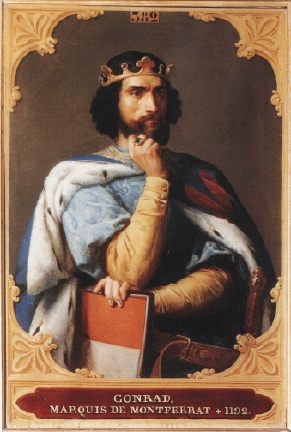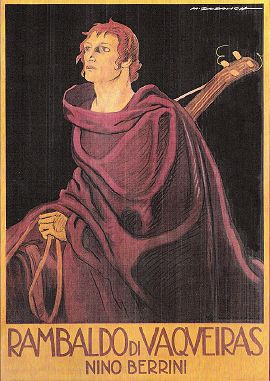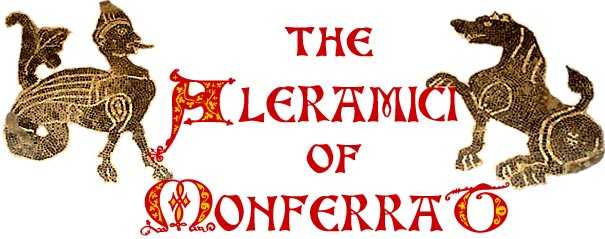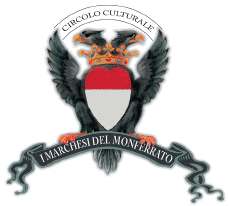

Kings, Crusaders, patrons of trobadors: one of the most extraordinary families of 12C, the Aleramici were Marquises of Monferrat (Modern Piemontèis: Monfrà or Munfrà, It: Monferrato, Fr: Montferrat), in Piemonte. The line can be traced back to 10C. Politically, they were vassals (but not always allies) of the Holy Roman Empire; culturally, they were part of the Occitan world. They were kinsmen of the Kings of France and of Castille, the Hohenstaufen Emperors, the Dukes of Austria, and most of Europe. They married into the royal houses of Byzantium and Jerusalem, and became Kings of Jerusalem and of Thessalonica. However, many of them met tragic ends...
 |
 |
I've written sizeable chunks of the Wikipedia articles on several of them (especially Conrad, whose biography was originally rather brief, and with whom I've been more than a little in love for over 25 years!), so have inserted links to those:
William V, the Elder (c. 1110/15-91)
Described by Acerbo Morena of Lodi:
Marquis William of Monferrat, who was a Lombard, was of medium height, well-proportioned and stocky, with a round, ruddy face, and hair that was almost white. He was extremely eloquent, virtuous and wise, merry and cheerful, munificent, but not prodigal.
m. c. 1133 Judith/Jutta/Ita von Babenberg (c. 1118-after 1168/before 1184), a younger daughter of Agnes of Germany and Leopold III of Austria.
William 'Longsword' (Guilhem Longa-Espia) (early 1140s-77), Count of Ascalon and Jaffa; father of Baudouin V ('Baudouinet') of Jerusalem
Described by William of Tyre:
The aforesaid Marquis was a young man of seemly height and praiseworthy appearance, with golden hair and manly spirit. He was irascible beyond the common measure, extremely generous, and frank of mind, who never wished to hide any of his intentions, showing openly whatever he carried in his thoughts. He over-indulged in food, and more so in drink, but never to the detriment of his wits. He was said to have had experience in the use of arms since reaching adulthood. He was so noble in worldly rank, that he was said to have few, if any, equals.
Conrad (c. 1145-92), Cæsar in Byzantium, King of Jerusalem
Described by Niketas Choniates in 1180:
...of beautiful appearance and comely in life's springtime, outstanding and exceptional in manly courage and intelligence, and in the flower of his body's strength.[...]
[...]This Conrad was an Italian by race; his father ruled over Monferrat. He so excelled in bravery and sagacity that he was far-famed, not only among the Romans [i.e. Byzantines] but also celebrated among his countrymen, and Emperor Manuel was especially fond of him as one graced with good fortune, acute intelligence, and strength of arm.
and in the Brevis Historia Occupationis & Amissionis Terræ Sanctæ:
Conrad was vigorous in arms, extremely clever both in natural mental ability and by learning, amiable in character and deed, endowed with all the human virtues, supreme in every council, the fair hope of his own side and a blazing lightning-bolt to the foe, capable of pretence and dissimulation in politics, educated in every language, in respect of which he was regarded by the less articulate to be extremely fluent. In one thing alone was he regarded as blameworthy: that he had seduced another's wife away from her living husband, and made her separate from him, and married her himself.
Boniface (early 1150s-1207), leader of the Fourth Crusade, King of Thessalonica, and one of the great patrons of trobar - most notably Raimbaut de Vaqueiras, also Peire Vidal, Gaucelm Faidit, Arnaut de Maruelh, & c.
Frederick (dates unknown), Bishop of Alba
Agnes, m. Count Guido Guerra of Romandiola. The marriage was annulled because of childlessness by 1180, and she entered the convent of Santa Maria in Rocca delle Donne.
????? m. Marquis Albert de Malaspina, a womaniser and trobador of whose work very little survives - a tenso with Vaqueiras and a couple of songs of uncertain attributions.
Renier (1162-82), Cæsar in Byzantium, m. Maria Komnene the Porphyrogenita. According to Choniates, at 17 he was beardless, and his well-groomed hair "shone like the sun".
Azalaïs (d. 1232) m. Marquis Manfred II of Saluzzo, and was later regent of Saluzzo for her grandson Manfred III. A patron of trobar, she was said to be beautiful, and is mentioned in songs by Peire Vidal and Gaucelm Faidit. She is buried at the Abbey of Santa Maria di Staffarda.
Family Song Book
And here's a chance to share some of the songs commissioned or inspired by the family and their adventures (links courtesy of Arnaut Malcovati, Brindin Press (for texts with translations by James H Donalson), RIALTO and Duca Lucifero):
Author |
Title |
Mentioned/Patron |
|---|---|---|
Arnaut de Maruelh |
Si.m destreignetz, dompna, vos et Amors |
Boniface |
Bertran de Born |
Conrad |
|
Elias Cairel |
Boniface his son William VI |
|
Carmina Burana |
Conrad |
|
Gaucelm Faidit |
Boniface |
|
Peire Bremon lo Tort |
En abril, quan vei verdeyar (with transl. by James H Donalson) |
William 'Longsword' |
Peirol |
Conrad |
|
Raimbaut de Vaqueiras |
Complete Works (bilingual ed.) (So much of his work was done for Boniface, just read the lot and sort out what isn't!) |
Boniface his daughter Beatritz Albert de Malaspina |
Peire Vidal |
Estat ai gran sazo Tant an ben dig del marques Baron, Jhesus, qu'en crotz fon mes Per mielhs sofrir lo maltrait e l'afan Bon'aventura don Dieus als Pizas Pus ubert ai mon ric thesaur |
Boniface Azalaïs |
Back to
TOP


